Wind parks as a pollutant source?
Wind park foundations are protected from corrosion by aluminium blocks: galvanic anodes. These galvanic anodes, however, release aluminium and heavy metal over time. As part of a cooperation project with the German Maritime and Hydrographic Agency (BSH) environmental chemist Dr Daniel Pröfrock and his team at Helmholtz-Zentrum Geesthacht (HZG) are now, for the first time, systematically studying how great the pollutant concentrations are and whether they present a possible new source of pollution in the North Sea. The task is demanding, as the concentrations are very low, causing conventional measurement methods to fail.
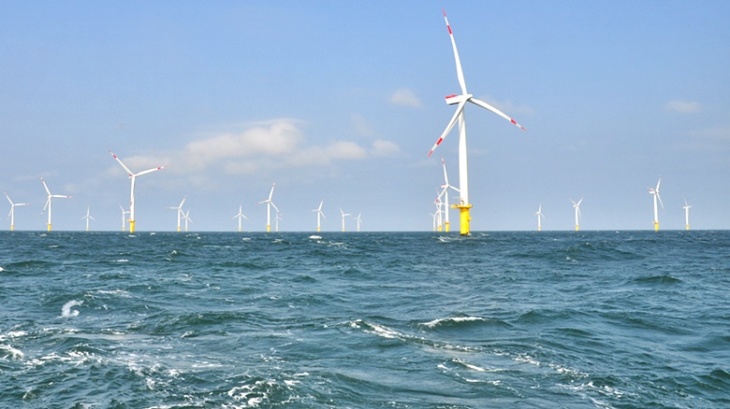
Wind park in the North Sea (Photo: Bettina Rust / HZG)
More than 1300 wind turbines are rotating today in the German North and Baltic Seas. In the last year alone 140 new turbines have begun operation. This trend is a welcome step from the standpoint of climate change. It is, however, also imperative to take a look at the possible negative consequences. Environmental chemist Dr Daniel Pröfrock from the Institute of Coastal Research at the HZG and his team are, for example, researching the extent to which chemical substances from the installations are released into the North Sea and potentially could become a problem for the environment.
Galvanic anodes as a metal cocktail
The experts are currently mainly studying corrosion protection of the wind energy installations in which galvanic anodes, also known as sacrificial anodes, are utilised. Galvanic anodes are large metal blocks that are affixed around the outer surface of the foundation. They consist of aluminium, mixed with an entire array of other elements. The galvanic anodes prevent the steel from corroding in the saline seawater. The seawater corrodes the low-grade aluminium-metal compound instead of the steel.
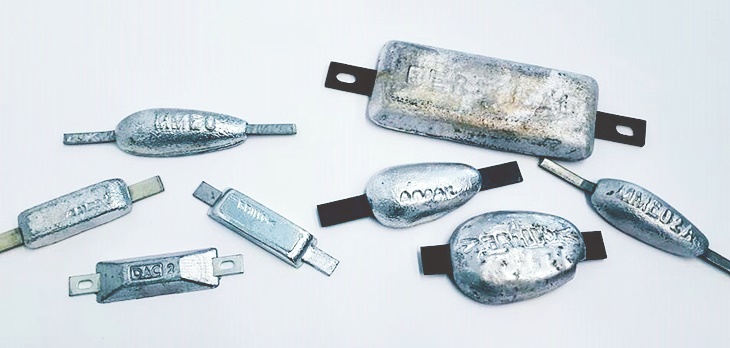
Galvanic anodes are used in various sizes and shapes as corrosion protection, e.g. for ships and hydraulic structures (Photo: Nathalie Voigt / HZG)
While the steel is protected, the galvanic anodes slowly dissolve over time. This dissolving process is continuous and leads to the sustained release of anode material and the elements contained therein. The number of galvanic anodes used in wind parks, however, is enormous. Depending on the type of foundation, a single wind turbine requires galvanic anodes around its foundation surface weighing up to ten tons in total for sufficient corrosion protection. The many galvanic anodes in a wind park altogether release many other metals over time, other than merely aluminium. These include known toxic elements, such as lead and cadmium, but also exotic elements, such a gallium and indium, about which very little is known of their behaviour in the environment.
Measuring the lowest concentrations
The project the team is working on is still in full swing. Therefore, Dr Daniel Pröfrock cannot yet say with certainty how much metal from the wind turbines winds up in the water. “We do not know the precise quantities, neither can we currently say whether the metals reach concentrations in the water that could present a danger to marine organisms,” says the chemist.
The concentrations the researchers are studying are incredibly low. The metals released by the galvanic anodes occur in concentrations of a few nanograms per liter (ng/L). This corresponds to a few metal ions that are dissolved in a quadrillion water molecules.
Dr Daniel Pröfrock and his team’s achievement lies in developing a method with which such low concentrations can actually be measured. “Conventional measurement devices have difficulties measuring such low concentrations in saltwater. We therefore needed to find our own solution.”
Developing a new measurement method
The team developed a method over months that examined the saltwater in two steps. First, disturbing chemical elements such as chlorine, and frequently occurring metals, such as sodium, calcium or magnesium, were removed from the water in a sort of filtration system. What remains is a highly concentrated mixture of heavy metals that can be analysed more precisely using a mass spectrometer. The mass spectrometer recognises different chemical elements by their mass and can determine how much of a heavy metal is present in the water sample.

Ultra trace analysis in the clean room laboratory (Photo: Christian Schmid / HZG)
Dr Daniel Pröfrock and his colleagues from HZG and BSH have meanwhile been on research vessel expeditions twice to take water and sediment samples, both in the wind parks and directly adjacent to the turbines. The actual work, however, begins in the laboratory, as the preparation of sediment probes is very labour intensive and each sample for measurement must go through several preparatory steps. The time required, from taking samples to the first measurements, can take several weeks to months.
Where does the heavy metal come from?
In addition, the researchers must still answer a second question: where do these measured metal atoms originate? Heavy metals, such as lead and cadmium, for example, can also wind up in the North Sea from rivers, the atmosphere, or from galvanic anodes on ship hulls.
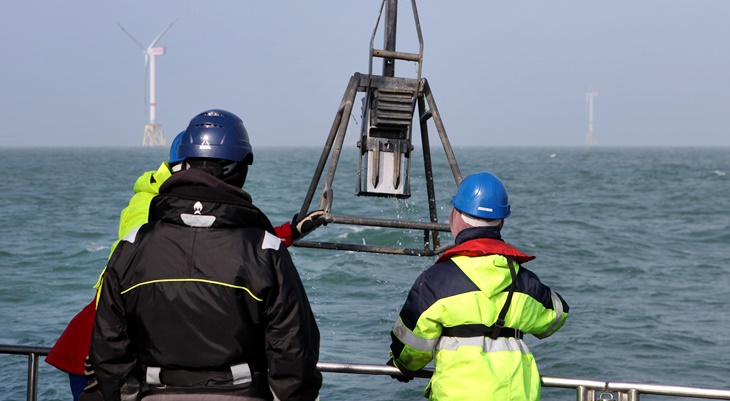
Sediment sampling with a box corer (Photo: Anna Reese / HZG)
The researchers must therefore be able to differentiate whether a metal atom in the North Sea stems from the wind park or from another source. In the future, they want to use a method that has been established for several years, but is nonetheless technically highly demanding and which they are initially testing on the heavy metal lead. This method is known as isotope measurement.
Isotopes are those atoms in a chemical element that differ in the number of neutrons and therefore exhibit a different atomic mass. Depending on the ore mine in which the lead was extracted, the ratios of the lead isotopes differ, which provides the lead with a characteristic fingerprint. Today it is known, for example, that different lead isotope patterns are prevalent in the coastal waters of the North Sea than, say, in the Elbe, as lead isotopes from different sources collect in the respective regions
Dr Pröfrock and his team of experts discovered from the first laboratory test that the galvanic anodes from different producers vary in their lead isotope composition. He hopes this knowledge can be transferred to the work in the North Sea in a way that they can precisely differentiate in the future whether the heavy metal in a sediment or water sample stems from a ship, from a river or from a galvanic anode in a wind park.
Cooperation with the BSH
Dr Pröfrock and his team work closely with the German Maritime and Hydrographic Agency (BSH) in Hamburg, which carries out regular contaminant measurements in the North Sea as part of their monitoring duties and has commissioned Dr Pröfrock and his team to work on such measurements in the wind parks. “The BSH is now about to establish our measurement methods for extremely low heavy metal concentrations in its laboratories so that they themselves can use these methods in the future.”
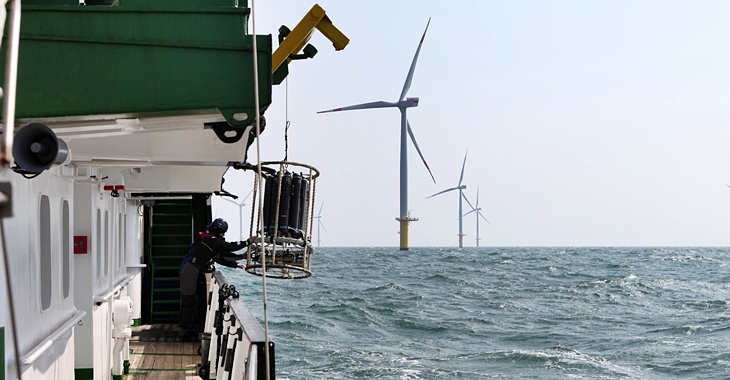
Water sampling in the wind park (Photo: Anna Reese / HZG)
Before the BSH can study the heavy metals from the wind parks on a regular basis, Dr Pröfrock and his team have plenty to do. The work is not merely limited to precisely measuring concentrations in the ng/L range alone. The currents in the North Sea must also be taken into account, as these can assert a very strong influence on heavy metal concentrations in the water.
It is the tides that mainly play a role here. The water in the North Sea is not like a river, with water always flowing in a certain direction. Rather, a water body moves back and forth through a constant change between ebb and flood. The water therefore remains longer in one region before it is slowly driven on by the wind. Ebb, flood and wind in the end lead to a water body moving in large-scale ellipses measuring approximately ten kilometres in diameter. That also means that the water body currently within a wind park is repeatedly moved via ebb and flood through the wind park itself.
Support from experts on currents
“This knowledge is very important for us when taking water samples,” says Pröfrock. “The longer the water lingers in a wind park, the greater the extent to which the heavy metals could possibly accumulate in this water body.”
Dr Ulrich Callies, expert on currents from the Institute of Coastal Research, recently developed the “DriftApp” together with his colleagues. With a few clicks, the app can determine in which direction a water body is currently moving in the North Sea and where it originated. You merely need to enter your own ship’s position and the app immediately calculates where the water, currently taken from the ship from the North Sea, comes from and where it is flowing.
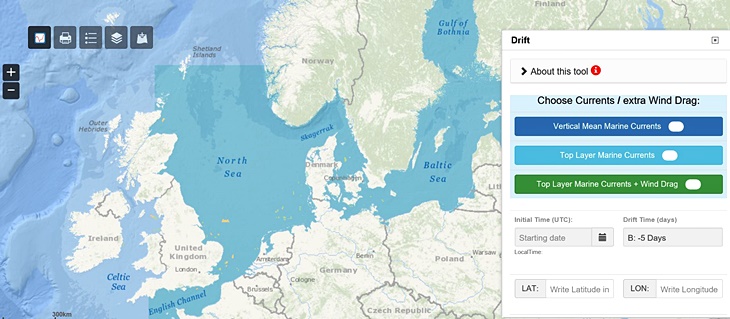
Access to the DriftApp (screenshot website)
The DriftApp calculates two days into the future, similar to weather reports, but can also look two weeks into the past and determine the path a water body has taken during this period. The DriftApp is a tremendous help to Dr Pröfrock and his team. “In the future, we can determine where we must steer the ship during an expedition in order to sample several times a body of water stemming from a wind park, for example, to see how it changes over time,” he says.
Simple app calculates complex currents
The DriftApp is also helpful for work in the laboratory. When analysing their heavy metal measurements, the researchers were able to later determine which direction the water had taken and how often it had traversed a wind park. The researchers must still evaluate many sediment and water samples with their sophisticated analysis equipment to be able to form a picture of the extent to which the heavy metals stemming from the wind parks present a serious contamination threat for life in the North Sea.
“The only thing that we can say for certain at the moment is that in the sediment directly adjacent to the older wind parks, higher heavy metal concentrations can be found in some locations,” says Dr Pröfrock. “Whether these values are potentially critical, we can only determine when we have an overview of the entire North Sea.” Time series will be of extreme interest, in which the researchers can see whether heavy metals accumulate in certain locations in or near the wind parks — so that their concentrations could be even higher than normal in the North Sea.
(Text: Tim Schröder, Science Journalist / English Translation: Anupa Srinivasan)
Contact Project OffChEm
Contact DriftApp


